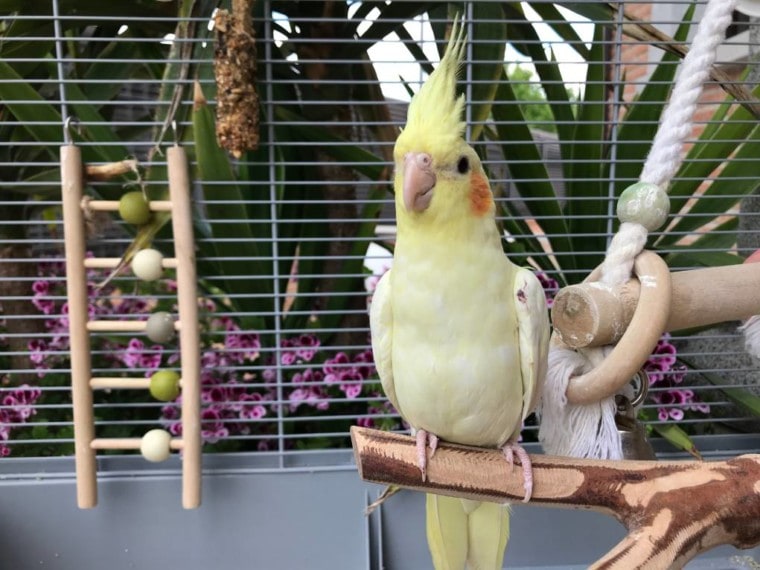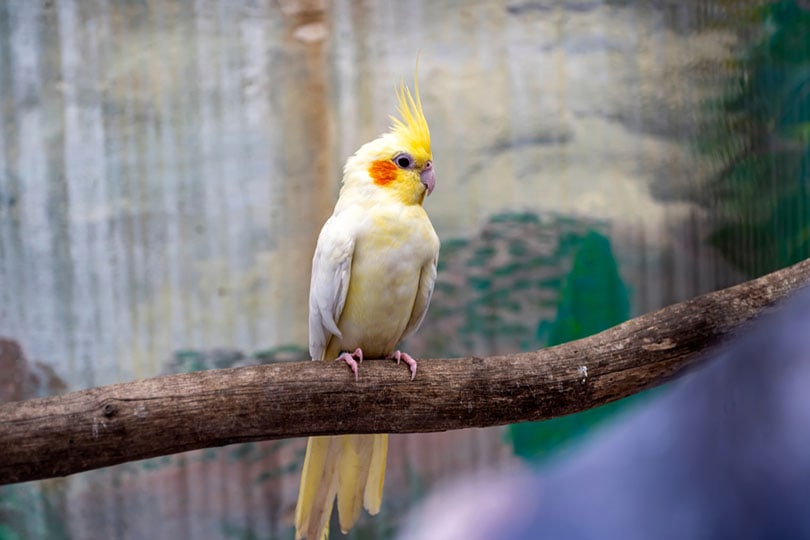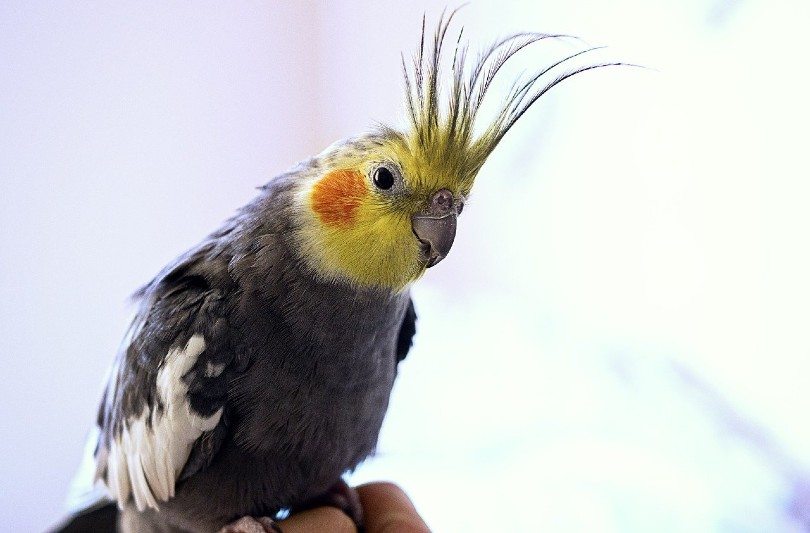
The Cockatiel is a small species of parrot that has become very popular as a companion pet. The cheerful, sociable, little whistlers will, with proper socialization, enjoy spending as much time as possible with their humans, positively thriving on the attention. Ensure a good diet and prevent them from eating anything toxic or potentially dangerous, and this Australian parrot species can live up to 30 years in captivity.
Nymphicus hollandicus is also known by the names Weiro Bird and Quarrion and they are popular parrots despite not being able to learn as many words as birds like the African Grey and living a shorter lifespan than the bigger birds.
Whether you are considering getting your first ‘Tiel or you simply want more information about this intriguing little bird, read on for 12 interesting facts about the Cockatiel.
The 12 Fascinating Cockatiel Facts
1. Male Cockatiels Make Better Whistlers
In nature, the male Cockatiel puts on a show to attract the female. The bigger and bolder the show, the more likely they are to attract a desirable companion. Even in captivity, the male retains its bold prowess. If you want a Cockatiel that can talk or one that is more likely to whistle happily behind you, then you should opt for the male of the species. Although the female will vocalize, she is more likely to sit quietly.

2. Some Can Talk
Chirps, warbles, and whistles are not the only sounds that this little parrot can make. Many are perfectly capable of mimicking human voices. They will mimic a lot of noises that they hear regularly so you can expect a thoroughly convincing alarm call at any time of the day.
One of the times when a Cockatiel is likely to speak or make another noise is when you leave the room. This inquisitive little gesture is equivalent to the bird trying to determine when you will be back. Whistle back and it should put your ‘Tiel’s mind at rest.
However, this isn’t the only reason that a Cockatiel will vocalize. They may let you know of what they perceive to be a danger. They will tell you when they are happy, and some will make a loud noise to let you know that they just want to be left alone. As well as chirps and whistles, all of these occasions are when a bird is most likely to vocalize.
If you’re new to the wonderful world of cockatiels, you’ll need a great resource to help your birds thrive. We highly recommend taking a closer look at The Ultimate Guide to Cockatiels, available on Amazon.
This excellent book covers everything from the history, color mutations, and anatomy of cockatiels to expert housing, feeding, breeding, and health care tips.
3. Males Also Look After Their Young
Somewhat unusually in the animal kingdom and especially with bird species, Cockatiels share some parental responsibilities. The male doesn’t abandon the female after they have mated, instead choosing to stick around in a bid to try and ensure the safety of the young. In fact, the male tends to be more loving and nurturing of their young than the female and they will readily take on bigger birds and some other animals in a bid to try and protect their young. Young Cockatiels need their parents for approximately the first 12 weeks of their life, and this means both parents, not just mum.

4. Cockatiels Were Discovered in 1770
The smallest member of the Cockatoo family, the Cockatiel lives in the Australian outback. It was first discovered in 1770 and it was noticed that they exhibit a lot of the same actions and perform the same activities as the larger Cockatoo species. During the Australian gold rush of the 1900s, the bird was exported from Australia as prospectors spotted the birds and started to take them home with them. Today, it is illegal to export the bird out of the country and all available pet Cockatiels are captive-bred birds, rather than wild-caught.
5. You Can Sense a Cockatiel Mood Using Its Crest
The Cockatiel is the smallest bird to have a head crest and while it looks very pretty, the crest is used for more than just decoration. You can tell the mood of your bird by looking at the shape and movement of the crest.
The head crest is just one way in which Cockatiels can communicate their emotions, though.

6. They Thrive on Companionship
Cockatiels are sociable little birds. In the wild, they live in flocks although they do only have one mate. In captivity, a Cockatiel will benefit from having a mate and can successfully be kept in an aviary with other small parrots and birds of the same or smaller size.
Unfortunately, they can be quite timid around other birds and they tend to get picked on. Their crest and long tail are especially prone to being chewed and plucked by bigger birds. If you don’t have a companion for your Cockatiel, be prepared to provide it with several mirrors and to offer several hours a day of companionship yourself.
7. They Love Mirrors
Cockatiels do love companionship, and they especially enjoy the company of other Cockatiels. Some say you shouldn’t give a Cockatiel a mirror because it encourages them to bond with the bird in the mirror and that bird always leaves. However, if you’ve given a Cockatiel a mirror, you will know the unbridled joy when it suddenly spots its reflection.
Generally, you should provide your bird with toys that enrich it mentally and that stimulate it. The mirror is one such toy.

8. Cockatiels Get Depressed
Providing a mirror is one way to stop your Cockatiel from becoming depressed, which they can if they are left alone or if they do not get the kind of mental stimulation that this intelligent little bird truly craves. Birds display some of the same signs of depression as people.
You will notice their mood change. They will become more reserved around you and may not want to get out of the cage as often. They are likely to eat less and let their appearance go. Fluffed-up feathers, aggression, and a change in their vocalization patterns are among the other signs you should watch out for.
9. Cockatiels Are Prone to Airborne Toxins
Cockatiels are incredibly susceptible to airborne toxins. This can include smells from aftershave or more dangerous toxins including smoke and even the burned Teflon layer from the inside of your frying pan. Take care with essential oils, too, because some are known to be dangerous to birds and other small animals.

10. They Can Bite
First of all, it is important to differentiate between biting and beaking. Beaking means that they are grasping onto you, usually for grip or balance, and it is not a sign of aggression. They may even lick your skin while doing this because the Cockatiel has a very sensitive tongue that is not only used to help taste or to manipulate food but also to determine texture. They can tell whether your hand is a good resting place by beaking and licking.
On the other hand, biting is usually a method of self-defense. This means that there is not usually any malice behind the bite, but you may have startled or scared the bird and it is reacting to this stimulus. The bite, which can be quite hard and very quick, will be accompanied by ruffled feathers and extended wings. Your cockatiel is making these actions to warn you away.
11. Some Appreciate a Night Light
Cockatiels are well-known for suffering from night frights. Rather than being a nightmare, it is likely that your bird has been startled awake. The bird will make noise and will usually flap their wings. Essentially, the bird is trying to get away from whatever startled them. Even if you pull back the cover and try to reassure the ‘Tiel, the flapping is likely to continue for a few minutes.
You do need to try and ensure that your Cockatiel does not injure their wing during one of these episodes because it can catch the tip on the bars of the cage or something else in their home.
You can provide a nightlight of sorts, but this should be very dim, and it should not illuminate the whole cage. The Cockatiel may choose to rest in the light and away from the shadows, but the illumination will allay fears quicker than your reassuring words, in most cases.

12. They Have a Lot of Dander
Cockatiels are one of several species of bird that produce a fine powder called dust. This is the same kind of substance as the dander that cats and dogs produce but is specific to birds. It can cause allergic reactions in people but the powder is important to your Cockatiel because it helps to keep their feathers silky and in good condition. This powder is not only found on Cockatiels but also on some other parrots. Avoid keeping the bird’s cage above dark furniture and be prepared to vacuum if your Cockatiel has a good shake when out of their cage.
Final Thoughts
Cockatiels are small parrots, but they play a big part in their owners’ lives thanks to their kind and loving nature, sweet temper, and the range of vocalizations and noises they make. We have listed 12 facts about this fascinating little bird but the best way to learn is to get one yourself and spend lots of time with it.
Featured Image Credit: Natalie Mnhc, Shutterstock









